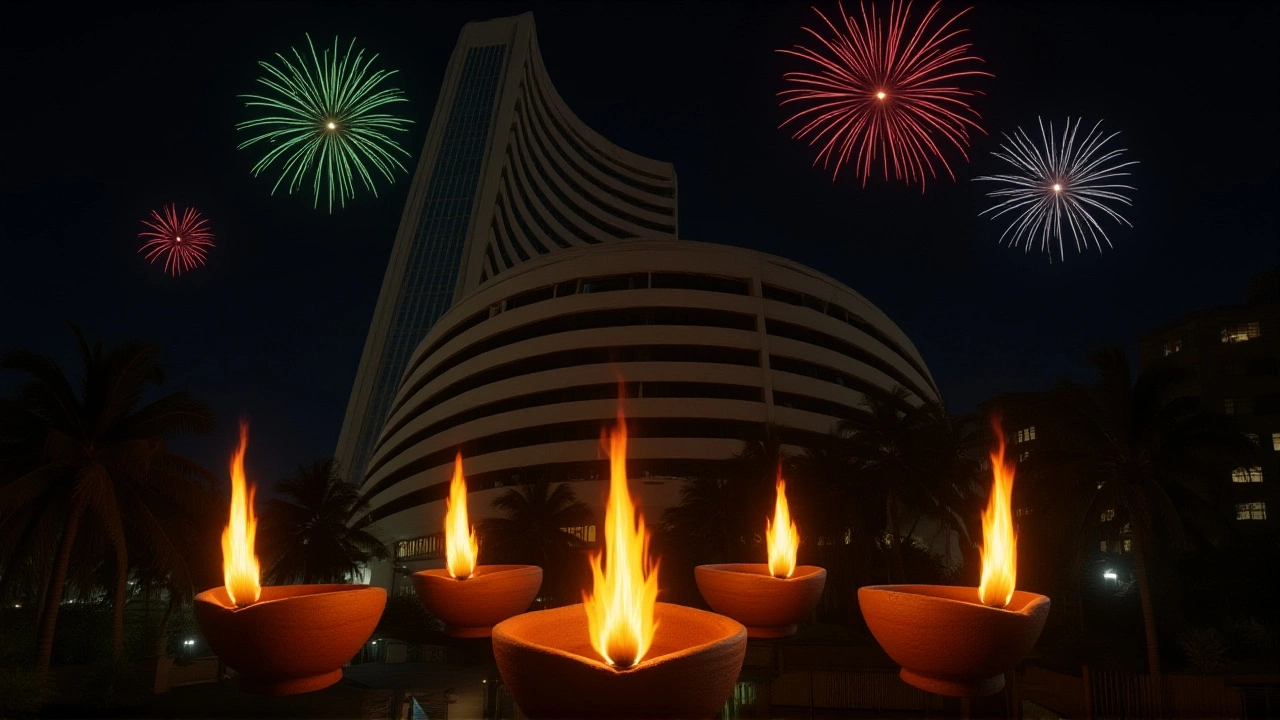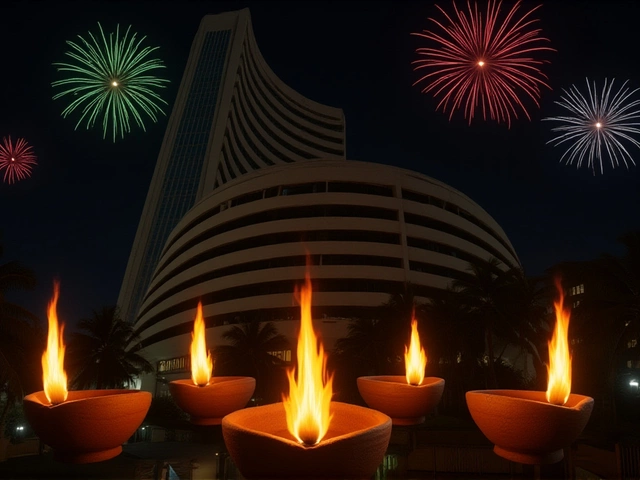Here’s the thing: the National Stock Exchange (NSE) and the Bombay Stock Exchange (BSE) will be closed on Monday, 21 October 2025 for Diwali Lakshmi PujaIndia. The move settles lingering confusion after some investors thought the holiday might fall on the 20th. While the exchanges stay shut for the day‑long observance, they’ll swing open for a one‑hour Muhurat Trading session from 1:45 pm to 2:45 pm IST, letting traders make symbolic first‑day bets for the new Samvat year.
Official Diwali Holiday Schedule
According to a report by Economic Times dated 19 October 2025, the two exchanges will also stay closed on Tuesday, 22 October 2025 for BalipratipadaIndia. After the Diwali break, investors have just three more market holidays this year:
- 22 October – Balipratipada
- 5 November – Prakash Gurpurab
- 25 December – Christmas
Those dates give traders a relatively tight calendar as the fiscal year draws to a close, so every trading day counts.
Muhurat Trading: Tradition Meets Modern Markets
The brief trading window isn’t just a ceremonial footnote. During the hour, equities, futures‑and‑options, currency and commodities can be bought or sold, and modifications are allowed until 2:55 pm IST. Brokers and family members often light diyas (oil lamps) at their terminals, believing the first trade sets a positive tone for the rest of the year. While the volume is typically modest, the session can create a noticeable blip in market data – the Nifty might tick a few points higher purely on sentiment.
For context, the Business Standard highlighted that on 14 October the Sensex had already slipped 790 points from its daily high, and the rupee was trading around 88.79 per US dollar. The same day, foreign institutional investors (FIIs) turned net sellers, liquidating ₹240.1 crore worth of Indian equities. Those numbers illustrate why even a symbolic trade can feel like a lifeline for a nervous market.
Recent Market Turbulence: From Crash to Fragile Recovery
The Indian market has been on a roller‑coaster since the start of 2025. A Wikipedia entry on “Stock Market Crashes in India” notes a “Crash of 2025” that began with early‑year weakness and peaked on 28 February when the Sensex fell more than 1,000 points in a single session. Analysts traced the plunge to a confluence of global factors – US economic slowdown, rising inflation, and higher interest rates – that prompted overseas money to flee emerging markets.
Domestically, soaring inflation, a jittery job market and policy uncertainty added fuel to the fire. Sectors such as information technology and financial services suffered the brunt, with Tata Consultancy Services, Power Grid and Tata Motors all posting declines of 2‑4 % in the week leading up to the Diwali holidays.
Regulators stepped in. The Reserve Bank of India intervened several times to stem rupee volatility, while the Securities and Exchange Board of India imposed temporary restrictions on short‑selling to curb excess moves. Despite a brief rally in March – driven by attractive valuations and renewed foreign portfolio investor (FPI) interest that pushed the Nifty Financial Services Index up roughly 9 % – the recovery was deemed fragile.
By mid‑October, the trend had turned sour again. The Economic Times reported that on 14 October the Sensex extended its slide to a fifth consecutive day, ending 555.95 points lower at 81,159.68, while the Nifty 50 fell 166.05 points to close at 24,890.85. Losses were broad‑based: small‑cap and mid‑cap indices slipped 0.6 % each, and IT stocks dipped more than 1 % after the US announced tighter visa rules for tech workers.
Analyst and Investor Sentiment
Market pundits are split. Some, like senior research analyst Rohan Mehta, head of equity strategy at Motilal Oswal, argue that the Diwali break offers a natural reset. “If the market can close the week on a modest gain during Muhurat trading, it could restore a slice of confidence among retail investors,” he said.
Others warn that the underlying macro‑headwinds remain unchanged. “Global rate hikes are unlikely to ease soon, and the rupee’s weakness at 88.79 per dollar is a red flag for foreign capital,” noted Anita Desai, senior economist at HSBC India. She added that the upcoming fiscal year‑end reporting season could either spark a bounce if earnings exceed expectations, or deepen the sell‑off if results fall short.
What Comes Next: Remaining Breaks and Outlook
After the Diwali and Balipratipada holidays, the market returns to a tight trading schedule. The next non‑trading day is 5 November for Prakash Gurpurab, followed by the year‑end Christmas break. Traders will be watching the RBI’s next policy meeting – slated for early December – for clues on interest‑rate direction.
In the short term, liquidity may stay thin, especially in the equity‑derivatives segment, making price swings more pronounced. Investors with exposure to the financial services sector should keep an eye on the Nifty Financial Services Index, which could act as a bellwether for broader risk sentiment.
Frequently Asked Questions
Why are NSE and BSE closed on 21 October 2025?
Both exchanges observe the Diwali Lakshmi Puja holiday on that date, as announced by the Economic Times. The closure aligns with national practice and gives market participants a chance to celebrate the festival.
What is Muhurat Trading and why does it matter?
Muhurat Trading is a one‑hour, symbolic session where investors place their first trades of the new financial year. Though volumes are low, the ritual is believed to set a positive tone and often sees a modest uplift in major indices.
How have recent market crashes affected investor confidence?
The 2025 crash, triggered by global rate hikes and domestic inflation, eroded confidence, especially among foreign institutional investors who sold over ₹453 crore this month. Recovery has been tentative, with occasional rallies offset by fresh sell‑offs.
Which sectors are likely to lead the market after the Diwali break?
Financial services showed a 9 % rebound in March and could lead if earnings stay strong. Conversely, IT remains vulnerable to external factors like US visa policies, while metal stocks may benefit from higher global commodity prices.
What should investors watch for in the coming weeks?
Key indicators include RBI’s monetary‑policy announcements, corporate earnings releases, and any fresh foreign‑institutional inflows or outflows. Liquidity will be thin around the holidays, so price swings could be sharper than usual.
- Poplular Tags
- Diwali
- NSE
- BSE
- stock market
- India











